Sound
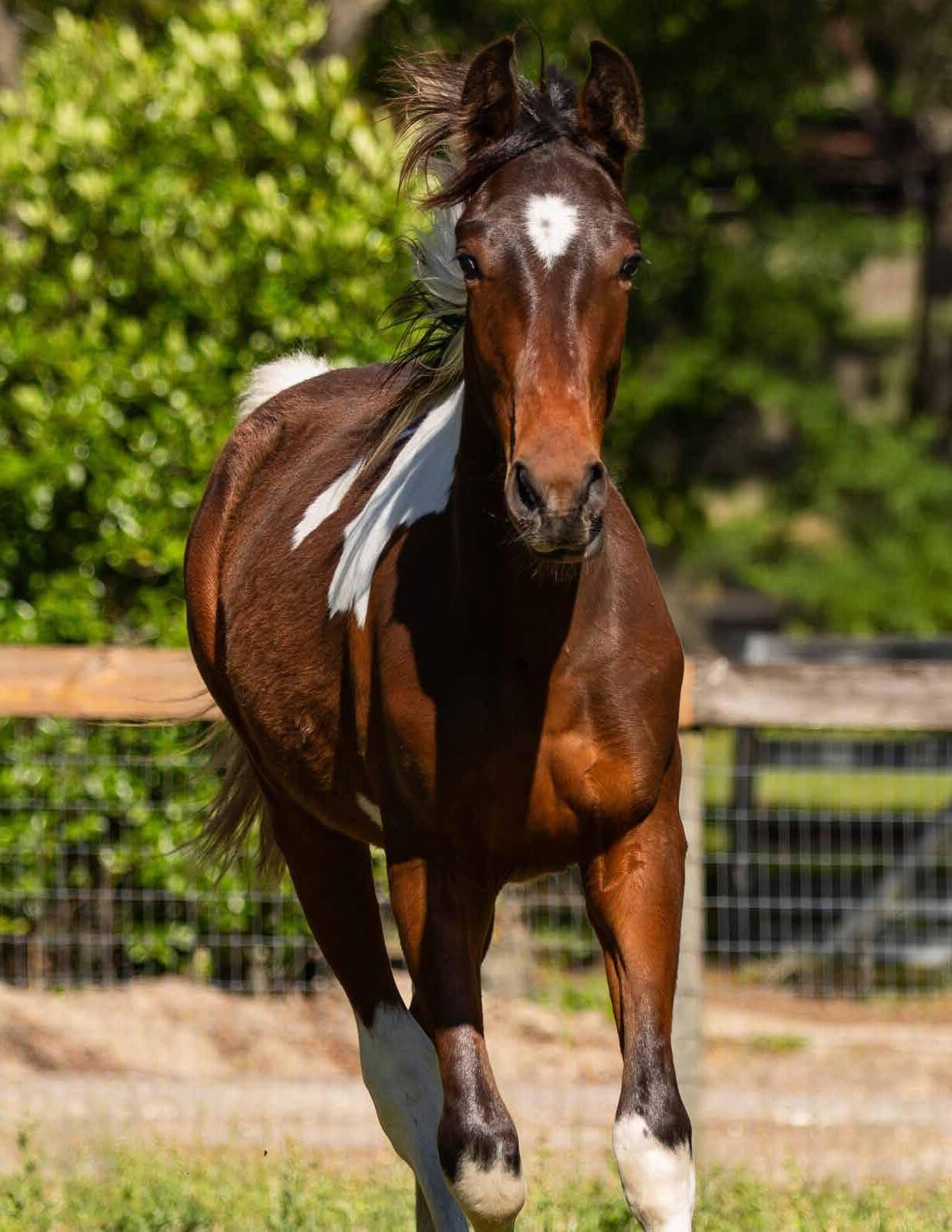
A Champion for All Gaited Horses
Volume 8, Issue 2, 2025
Sound Advocate
Friends of Sound Horses, Inc. 6614 Clayton Rd. #105 St. Louis, MO 63117 info@fosh.info * www.fosh.info
Board of Directors
President - Teresa Bippen Missouri Tbippen1957@yahoo.com
Secretary/Treasurer-Gina Vehige Director at Large-Bill Coon VP IJA Program-Dianne Little Missouri Utah Alberta, Canada gvehige115@gmail.com wbotis@gmail.com ddlittle@telus.net
VP Programs/Gaited Sport Horse Director at Large-Anita Dunham VP HIO/DQP-Lisa Harris
Dianne Little Missouri Tennessee Alberta, Canada dunhamanita@gmail.com ddlittle@telus.net
Executive Advisory Committee
Keith Dane Patti Potts Pauline Stotsenberg Hawaii Missouri California pottspa@gmail.com ps@yesteryearfarms.net
Editor Stephanie J. Ruff Florida editor@fosh.info
FOSH Mission Statement
To promote all “sound,” naturally gaited horses, with a specific emphasis on Tennessee Walking Horses. (In this context, sound means not “sored”.)
Importance is placed on education in regards to the humane care for the emotional, mental and physical wellbeing, training, and treatment of all gaited horses.
FOSH will only support flat shod or barefoot horses and will never endorse any event that uses stacks and/or chains as action devices, or any mechanical, chemical, or artificial means to modify the natural gaits of the horse.
To these ends, FOSH focuses on three areas for gaited horses:
1) educating people about sound horse training principles;
2) supporting sound shows, events and activities;
3) working to end soring.
FOSH is a 501(c) (3) non-profit organization. All donations are tax deductible to the extent permitted by law. Your donation to support the FOSH mission is needed to advance the goals set forth by FOSH in conjunction with its formal mission statement.

Publication Guidelines
The Sound Advocate is a digital magazine published quarterly by Friends of Sound Horses, Inc. Reproduction of any article is prohibited without the express written permission of FOSH.
FOSH accepts unsolicited submissions, but reserves the right to edit any and all submissions for content, style and space constraints. FOSH further reserves the right to refuse advertising for any reason.
At no time shall the publisher’s liability exceed the total cost of the revenue from advertising in the issue involved in any dispute.
All show suspensions and show results are printed as they are received from the reporting agencies. FOSH does not guarantee their accuracy.
FOSH does not endorse the content of any advertisement in this publication, nor does it warrant the accuracy of any advertisement.
Readers are urged and cautioned to use due diligence and to thoroughly research, including asking for references, before following through with any transaction.
FOSH does not endorse any trainer, educator, clinician, style of natural training, tack, or horse equipment to the exclusion or preference of any other. Each horse is an individual and may respond differently to particular methods.
Articles published by FOSH reflect the views and opinions of the writers and do not reflect, necessarily, those of FOSH.
Publication Information
Subscribers: The Sound Advocate is a benefit of membership. To ensure that you receive your issues, be sure that your e-mail address is current. To change an e-mail address, contact gvehige115@ gmail.com.
Submission of Articles, Calendar Dates, News and Photos: Send to tbippen1957@yahoo.com. Photos may not be embedded in text and must be submitted as jpeg format, minimum of 300 dpi. The deadline for each issue is the 15th of the preceding month when the issue is to be released. Submissions will not be accepted after the deadline, but may be carried over to another issue. Submissions will not be returned to the submitter.
Member’s Advertising Rates
Back Cover $300
Inside Front Cover $275
Inside Back Cover $275
Full page $125
Half page $75
Quarter page $60
Business Card $25
Directory $25
Discounts for Multiple Issues
2 issues - 10% off total fee
4 issues - 20% off total fee
6 issues - 30% off total fee
Ads will be accepted in pdf, tif or jpeg formats. Text and photos must be e-mailed separately by the 10th of the month when the issue is released. Photos must be 300 dpi. Camera-ready ads are emailed at 300 dpi. Materials should be emailed to editor@ fosh.info.
All advertisements must be paid in advance by check, money order, or credit card. Payments should be made out to FOSH and mailed to:
6614 Clayton Rd. #105 St. Louis, MO 63117
More FOSH information can be found online. Find us at www.fosh.info.
Like us on Facebook.

On the cover: Gravedigger’s Painted Cash is a 2024 Spotted Saddle Horse owned by Spotted Dance Ranch of Brooksville, Florida. He is by Digger’s Mischief Managed and out of Cash’s Outlaw. Photo credit: Shannon Castaneda.
From the President...
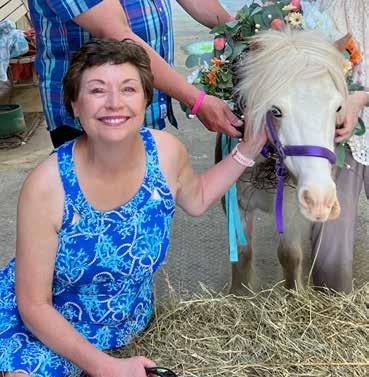
Dear FOSH Friends and Supporters,
I hope you’re enjoying sunshine and warm riding weather. After our record-breaking, spring rains, I know folks are happy to not deal with mud and just get out and ride!
Do you want to get together and visit with sound horse people for a few days in Missouri this Autumn? We’re getting excited about our first ever FOSH-sponsored Carl Bledsoe clinic at the National Equestrian Center in Lake St. Louis. Carl’s clinics are popular whether you are a novice or experienced rider. Several Board members and Executive Committee members are attending and participating, and we would love to enjoy your company. If learning by observing is your style, you can sign up as an auditor. The dates are September 19-21. I know you will enjoy Carl’s kind approach and conversational style and meeting his wife, Tammy. I have visited with them over the years and am really looking forward to spending time with them again. More information is on page 12 including details on scholarships.
We’re hearing concerns about the USDA regulations which were released but not implemented. Unfortunately, at this time, we’re in a lull which is leading to much misinformation for all horse shows. The devil is in the details, and we’re waiting for clarification at this point. For 2025, however, the HIOs will still be conducting inspections and stacks and chains are permitted.
On a more positive note, FOSH attended the American Horse Council (AHC) annual meeting this year after being absent for several years. We were warmly welcomed which I attribute to our previous AHC representative, Alece Ellis. Alece was a FOSH Director when she passed away four years ago, and she is still greatly missed by all those whose lives she touched. Memories of our friendship comes rushing back to me when I learn of the positive impact she had with many of the AHC members.
After a recent trip to beautiful Maine (my first one), I was struck by how lucky I am to live in a state where I enjoy my horses and the outdoors pretty much year-round. Learning that some towns shut down for 4-6 months (only a few businesses stay open) was eye-opening. While driving for hours on rural roads, we spotted horses only once which surprised me as it looked like wonderful trail riding would be available. I guess the plethora of book and craft (knitting, needlework, cross-stich) stores should have informed me that there is a lot of down time in a cold and snowy state.
From the Editor...

Hello FOSH Friends.
Summer is here. If you live in hot climates like Florida and Arizona, it’s time to hibernate in the air conditioning. For much of the rest of the country it’s prime riding season. As the temperatures rise, responsibilities to our horses change so you might be interested in checking out 10 tips to help your horse in the heat.
If you compete or trail ride in groups—anything that involves coming into close quarters with horses from a different area, you might want to consider biosecurity. It’s not something many people think about, but allowing horses and even equipment from different areas to mingle is a main way many diseases and illnesses are spread. To help avoid this, check out the biosecurity article from Equine Guelph.
This issue begins a new series from Jim Fiorini, better known as Jim the Feed Guy. His Facebook page describes him as “Horse feed specialist with industry insider experience helping owners understand the proper use of commercial feeds while advocating for more transparency from feed and supplement companies.”
Jim generously offered to write nutrition-based articles for us with the first one appearing in this issue. It covers forage. While many people focus on feeding concentrates, grains, and supplements, pasture and hay remain the foundation of every horse’s diet. As such, that is the topic of his first article.
We thank Jim for bringing his unique perspective of equine nutrition to us. Are there any feed-related topics you would like to learn about? Please drop me an email and let me know.
Do you recognize this issue’s cover model? That’s Gravediggers Painted Cash. He actually was on last summer’s cover as a foal. He’s growing up to be a very handsome man!
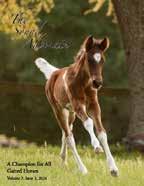
Stephanie
Stephanie J. Ruff Editor, editor@fosh.info
Letter to Dr. Louis DiVincenti USDA-APHIS-Animal Care
Dr. Louis DiVincenti Acting Animal Welfare Operations Director, USDA-APHIS-Animal Care 2150 Centre Ave, Building B, Mailstop 3W11 Fort Collins, CO 80526-8117
Re: Horse Protection; Amendments to the Horse Protection Regulations [Docket No. APHIS-2022-0004], RIN: 0579-AE70
Dear Dr. DiVincenti,
Friends of Sound Horses (FOSH) submits these comments in response to the U.S. Department of Agriculture (USDA) Animal and Plant Health Inspection Service’s (APHIS) (“the Agency”) request for comments on the rule entitled, “Horse Protection; Postponement of Regulations,” which delays implementation of portions of the May 2024 Final Rule amending the agency’s Horse Protection Act Regulations, 89 Fed. Reg. 39194 (May 8, 2024) (amending 9 C.F.R. pt. 11 ) (“2024 Final Rule”).
While we understand that certain provisions of the 2024 Final Rule were vacated by the United States District Court for the Northern District of Texas in the case of Tennessee Walking Horse National Celebration Association v. USDA et al.,
essential provisions of the rule were upheld by the court, including the elimination of industry self-policing and the shift to federally trained inspectors. We were, and continue to be, in support of these provisions from the 2024 Final Rule and their prompt implementation, as we agreed with APHIS that these amendments are necessary to ensure efficient and effective enforcement of the Horse Protection Act (HPA).
The 1976 amendments to the HPA authorized the creation of USDA-certified Horse Industry Organizations (HIOs) to train and oversee Designated Qualified Persons (DQPs), who could then be appointed by show organizers to inspect horses for soring. The HIO-based self-policing system that the upheld provisions of the 2024 Final Rule replaces is inconsistent with the mandate and intent of the HPA to end the soring of horses, and the 2024 Final Rule must be implemented without further delay. We urge the agency to immediately implement the provisions of the 2024 Final Rule that were upheld by the U.S. District Court for the Northern District of Texas, and in no case allow any further delays.
FOSH is a not for profit 501(c)(3) equine welfare organization that has
worked to end the soring of Tennessee Walking Horses and other gaited breeds for 25 years. FOSH’s members are Tennessee Walking Horse owners, breeders and exhibitors.
FOSH is a USDA certified Horse Industry Organization (HIO) and has participated in USDA meetings, Listening Sessions and has submitted comments in support of stronger regulations to end horse soring as Congress intended when it passed the HPA.
FOSH has organized and held four Sound Horse Conferences which provided a forum for expert equine veterinarians and animal welfare experts to share evidence about the abuse of soring and the need for stronger enforcement of the HPA.
In December 2013, FOSH, along with the American Horse Protection Association and Donna Preston Moore, DVM, MS, submitted draft regulations to implement the recommendations contained in a 2010 USDA Office of the Inspector General (OIG) audit – specifically, to end the HIO system of industry self-policing which the OIG said was a failure and should be abolished (with which the Agency agreed). FOSH strongly supports the termination of the HIO program and its replacement with the Horse Protection Inspector program contained in the 2024 Final Rule.
FOSH’s Comments are:
1. As a USDA-certified HIO, FOSH’s primary goal is the prevention, detection and ultimately, the elimi-
nation of soring. Although USDA personnel (Veterinary Medical Officers, or VMOs) have found virtually no violations of the HPA at shows inspected by FOSH DQPs over the years, the experience of other HIOs – particularly those that inspect events containing “big lick” horses wearing pads and action deviceshas been very different. The USDA OIG, APHIS, the National Academies of Science, Engineering and Medicine and third party non-governmental organizations have all thoroughly documented throughout time that DQPs licensed by those HIOs routinely fail to identify violations of the HPA. They detect virtually no violations when VMOs are not present, detecting violations only when VMOs are present, at a much lower rate than VMOs.
The HIO system has been a failure at protecting horses from soring, and for the HPA to be effectively enforced, that system must be abolished. FOSH does not believe implementation of the 2024 Final Rule will adversely impact FOSH as it relates to Horse Protection Inspectors (HPIs) assuming the inspection duties of FOSH DQPs. In fact, further delay of the 2024 Final Rule will adversely affect FOSH and its members who continue to suffer due to the stigma that soring casts over the breeds, the horses in which are devalued by the practice.
2. Since the release of the OIG audit in 2010, over many years, significant Agency effort and public input has
gone into the development of the case for (and regulations to implement) a system of enforcement that is free of conflicts of interest that has the ability to effectively enforce the HPA with a goal of eliminating soring. The Agency has twice proposed and finalized (in 2016 and 2024) a rule that would end the HIO self-policing system and replace it with a program of inspectors that would operate under the authority of the Agency rather than industry. Twice the Agency has failed to implement those rules, which carry the weight of law – leaving horses to continue to suffer from soring (the evidence of which has gone largely undetected by industry DQPs who solely inspect horses at the vast majority of events containing “big lick” horses) – and leaving the HPA virtually unenforced at those events.
3. FOSH endorses all comments made by Humane World for Animals submitted to the USDA on May 20, 2025 in support of swift implementation of the upheld portions of the 2024 Final Rule, with no further delays.
Sincerely,
Teresa Bippen
President,
Friends of Sound Horses
6614 Clayton Road, #105 St. Louis, MO 63117 www.FOSH.info

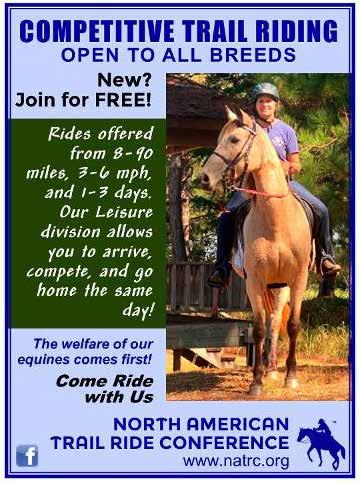
Carl Bledsoe Horsemanship Clinic #5 at Spotted Dance Ranch
By Kym Rouse Holzwart
In December 2022, Carl and Tammy Bledsoe held their first clinic at our ranch, Spotted Dance Ranch in Brooksville, Florida. We have been privileged, humbled, and honored that these amazing teachers and horse trainers continue to return each year to hold additional clinics. We hosted their fifth clinic at our ranch March 8-10.
Thank you to FOSH for sponsoring this clinic! In addition, covering costs for hosting Carl and Tammy and for holding the clinic, we used the funding to improve the clinic experience for all participants. We hosted a hamburger dinner on our porch the first night and a pizza dinner around a campfire on the second night. We also were able to provide coffee and continental breakfast items each morning, as well as drinks and snacks each day.
If you have not yet attended a Carl Bledsoe Horsemanship Clinic, you are really missing out on something special. While Carl and Tammy specialize in gaited horses, they work with all breeds and disciplines since their methods are based in classical horse training and are applicable to all horses. Each clinic is different since Carl continues to learn from others. However, presentations and exercises, which are both from the ground and in the saddle, focus on soft feel and subtle cues, horse-led learning, horse behavior and body
Brooksville, Florida language, a holistic approach, and rider self-awareness and development. It is amazing to watch the improvements of horse and rider not only over the three days, but also over time, since many participants return clinic after clinic. I have learned so much watching and participating with my Spotted Saddle Horse mares. The Bledsoe philosophy takes time, patience, proper feel, and the correct timing; however, your horse will thank you for it!
The Bledsoes will be back at our
ranch for Clinic #6 December 6-8. This clinic is also being sponsored by FOSH and sign up soon since it will fill! Call or email Tammy to sign up for the clinic (carlbledsoehorsemanship@gmail.com, 770-403-4635).
Contact Kym at Spotted Dance Ranch (kymrouse@att.net, 813-4824028) for clinic accommodations and for auditing information (once the clinic is full, auditing opportunities will be available each day). We can’t wait to host the next Carl Bledsoe Horsemanship Clinic in December!
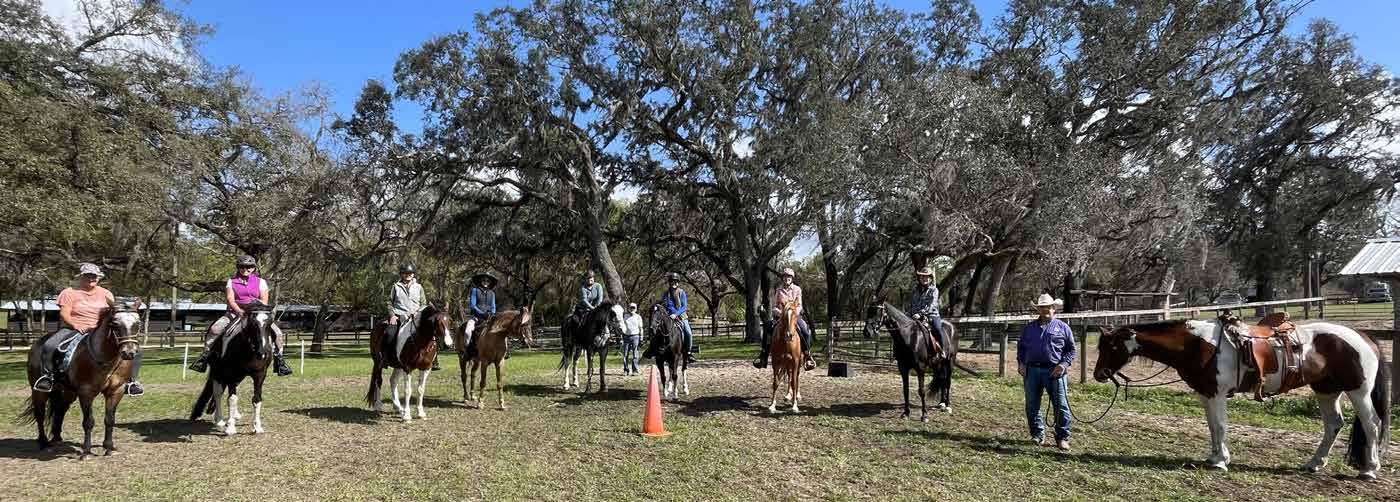
2025 Sound Horse Clinics & Events
Supported by FOSH
Schedule will be updated as more events are added.
Date Location Sponsor/Contact Type
September 19-21 Lake St. Louis, MO Carl Bledsoe/FOSH
December 6-8
Gaited Horse Clinic
Brooksville, FL Spotted Dance Ranch-Kym Rouse
Carl Bledsoe Clinic

Carl Bledsoe Clinic National Equestrian Center
Lake
St. Louis, Missouri
September 19-21, 2025

Sponsored by FOSH

CARL BLEDSOE CLINIC
National Equestrian Center
6880 Lake St. Louis Blvd. Lake St. Louis, MO 63367
September 19 -21, 2025
SCHOLARSHIPS NOW AVAILABLE!
Friends of Sound Horses, Inc. (FOSH) is now offering 1 adult (19 and up), and 1 youth (age 14 -18) riding scholarship to the Carl Bledsoe Clinic being held in Lake St. Louis, MO in September of 2025. In addition, 3 auditor scholarships will also be availab le. Riding positions are normally $800 for all 3 days, and auditors are normally $50 per day. The scholarships would cover these fees only. Applicants will be responsible for their own (and horses, if appliable) transportation, lodging, meals, and stall shavings (which must be purchased from the venue). Stall fees are included. Applicants must agree to FOSH Sound Horse Principles as stated in this edition of the Sound Advocate and complete a clinic application if selected.
Please complete the attached information and scan and email to: treasurer@fosh.info before June 1, 2025. Thos selected will be notified before July 1, 2025. Scholarships are NON -TRANSFERRABLE.
I am applying for: ________ Rider * ____________ Auditor (check one)
*Riders must be able to and have been riding the horse for at least 6 months.
Name:_____________________________________________________ (PLEASE PRINT LEGIBLY)
Address:___________________________________________________
Email: ____________________________________
Phone: ____________________________________________________
Breed of Horse:
How Long Have You Owned the Horse? _______________________
I agree with the FOSH Sound Horse Principles (in this edition of the Sound Advocate): Y or N (circle)
Why do you want this scholarship and what do you hope to learn from the clinic?
(may include additional pages as necessary)
AAEP Publishes Updated Internal Parasite Control Guidelines
Edited press release
The American Association of Equine Practitioners (AAEP) issued revised Internal Parasite Control Guidelines to help minimize risk of parasitic disease and maintain effectiveness of current drugs for as long as possible by delaying further development of anthelmintic resistance.
The guidelines, originally created in 2013 and last revised in 2019, account for recent advances in knowledge concerning increased anthelmintic resistance and optimization of parasite control management practices. The guidelines also address common misconceptions and offer parasite control program recommendations for senior horses (over 15 years old), mature horses (between 5 and 15 years old), and young horses (under 5 years old).
“We have seen dramatic development in the field of equine parasite control over the past 10 years, since we first launched these guidelines, and we work hard to keep our recommendations up to date,” said Martin Nielsen, DVM, PhD, DVSc, DAVCM, DEVPC, Schlaikjer Professor
of Equine Infectious Diseases at the University of Kentucky.
Important conclusions to be drawn from the revised guidelines are to:
• Perform fecal egg count reduction tests annually to ensure that you are using effective dewormers in every herd or barn.
• Recognize that no anthelmintic will eliminate all parasitic stages from a horse.
• Continue using fecal egg counts once or twice per year to stratify horses into low, medium and high shedders to reduce pasture contamination.
• Deworm all horses at a baseline rate and target selected horses more often based on fecal egg counts.
• Not use fecal egg counts to diagnose disease in horses as there is no correlation between fecal egg counts and disease-causing parasite life stages.
• Discontinue deworming all horses with fixed intervals year-round and stop blindly rotating anthelmintic classes.
Parasite Control Guidelines Task Force, chaired by Dr. Nielsen and comprised of 10 AAEP members predominantly board certified in veterinary internal medicine, veterinary parasitology and/or veterinary microbiology. The updated guidelines were reviewed and approved by the AAEP Infectious Disease Committee and board of directors.
View the guidelines or save them to your mobile device at https://aaep. org/resource/internal-parasite-control-guidelines. AAEP members may also access the guidelines through the AAEP On-the-Go app; search “AAEP On-the-Go” at your app store to download.
The guidelines were reviewed and updated by the AAEP Internal

10 Tips to Help Keep Your Horse Cool This Summer
Hot and humid weather can take a serious toll on your horse’s health and performance. Whether your horse is in light work or heavy training, managing heat stress is critical for their comfort and safety. Here are 10 practical tips to help keep your horse cool, hydrated and healthy all summer long.
1. Provide constant access to clean, cool water
Dehydration can sneak up quickly in the heat. Make sure your horse always has access to fresh water. In very hot weather, some horses drink more when their water is slightly cool and free from debris or algae.
2. Offer electrolytes as needed
Sweating depletes sodium, potassium, and chloride. Supplement with electrolytes—especially during heavy work or if your horse is a heavy sweater. Choose an electrolyte formulated
for horses and consider adding it to water or feed.
3. Create shade options
If your horse is turned out during the day or 24/7, provide access to shade from trees, run-in sheds or shelters. Avoid turning horses out during peak heat hours when possible (typically 11 a.m. to 4 p.m.).
4. Turn out at night or early morning
If your horse stays in a stall, shifting turnout to overnight or early morning helps your horse avoid the hottest part of the day. This simple schedule change can dramatically improve their comfort.
5. Use fans in the barn
Proper ventilation is essential. Fans
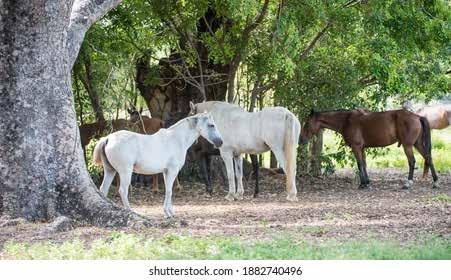
help move air through the barn, keeping horses cooler and reducing the risk of respiratory issues. Be sure to use fans rated for agricultural use to minimize fire risk.
6. Hose down or sponge off
Cold-water hosing is one of the most effective ways to reduce a horse’s body temperature. Focus on large blood vessel areas like the neck, chest, and legs.
7. Avoid intense work during peak heat
Schedule your riding or training sessions during cooler times—early morning or evening. Monitor your horse for signs of overheating, such as excessive sweating, heavy breathing or lethargy.
8. Clip long or heavy coats
Horses with thick summer coats (especially seniors or those with a metabolic disorder) may benefit from a body clip to stay cool. Be sure to use fly protection if the coat is clipped very short.
9. Soak and chill feed
Soaking hay and feed can encourage hydration and help reduce dust. Additionally, you can offer chilled treats like frozen apples, carrots or specially formulated horse popsicles as a fun cool-down.
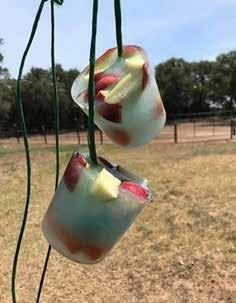
10. Know the signs of heat stress
Be vigilant for signs of heat stress or heat stroke: rapid breathing, elevated temperature, weakness, or refusal to eat or drink. Act quickly—move the horse to a shady area, hose them off with cold water, and contact your veterinarian if symptoms persist.
Final
Thought:
Summer is a great time for riding, competitions and trail adventures— but your horse relies on you to help regulate his temperature and recovery. By following these tips, you can help ensure your horse stays cool, healthy and happy even in the hottest months.
There is a big focus on feed programs, feed types, nutritional supplements and other nutritional or performance enhancing products for horses. I’m always asked my opinion about this feed or that, this supplement or that. I am rarely asked about forage type, quality or quantity. Many clients are surprised when I arrive for a feed consult, and the first place I want to visit is the hay loft.
Most owners are aware of the challenges that pasture grazing poses although they really aren’t clear why pasture poses those challenges.
The general perception of hay among some owners, especially new owners, is that it is provided as a filler and contributes little to the nutrition or caloric requirements of horses. It is unfortunate because hay is not just a very important component of the equine diet it is without question paramount in our quest to feed horses.
When we consider how the horse was designed to consume and process its food it is easy to understand why forage should be the first consideration in choosing a diet for your horse.
Forage covers a large array of grass
Feeding Forage First for Horses
and legume-based plants including pastures. Forage is the most challenging to manage because of the variety and availability by geographical area, weather and a few other factors. A bag of feed will provide consistent nutrition but hay and grass not so much.
Let’s take a look at some types of forage.
Pasture Grass for Horses
If you have enough pasture to help support your horses that’s great because it can cut down on your hay bill. I am going to put it out here right now that although there’s a ton of information about when it’s safe to turn horses out on grass there is never a truly safe time to do so. Grass is a living organism, and as such it is always changing its profile.
Grass is the source of most forage whether it is pasture or hay. Grass comes in many varieties and depending on how it is maintained and what time of year has wildly varied nutritional values. This is why pasture can be the trickiest way to feed a horse.
Of course, it depends on what part of the country you are from. I spent most of my life in the Northeast
By Jim Fiorini,
and Mid-Atlantic states where the cold weather grasses are typically lush and rich in nutrients as well as sugars. In my work I see many cases of spring grass founder. Everyone worries about spring colic, but many more horses are impacted by laminitis than by colic because of too much pasture.
There are also many confusing theories on grass management, and many apply across all species of grass and all parts of the country. Before I proceed, I would encourage
aka “Jim the Feed Guy”
you to spend some time with your local ag extension to learn more about the grasses of your local area.
Grass is basically a little sugar factory. Grass uses photosynthesis to convert the nutrients it absorbs from the ground into sugars to sustain its growth. When the sun is shining the factory is working and making sugars for the grass to grow. Based on this it is easy to assume that there is more sugar in the grass stalk when the sun is high and hot, but this is not always the case.
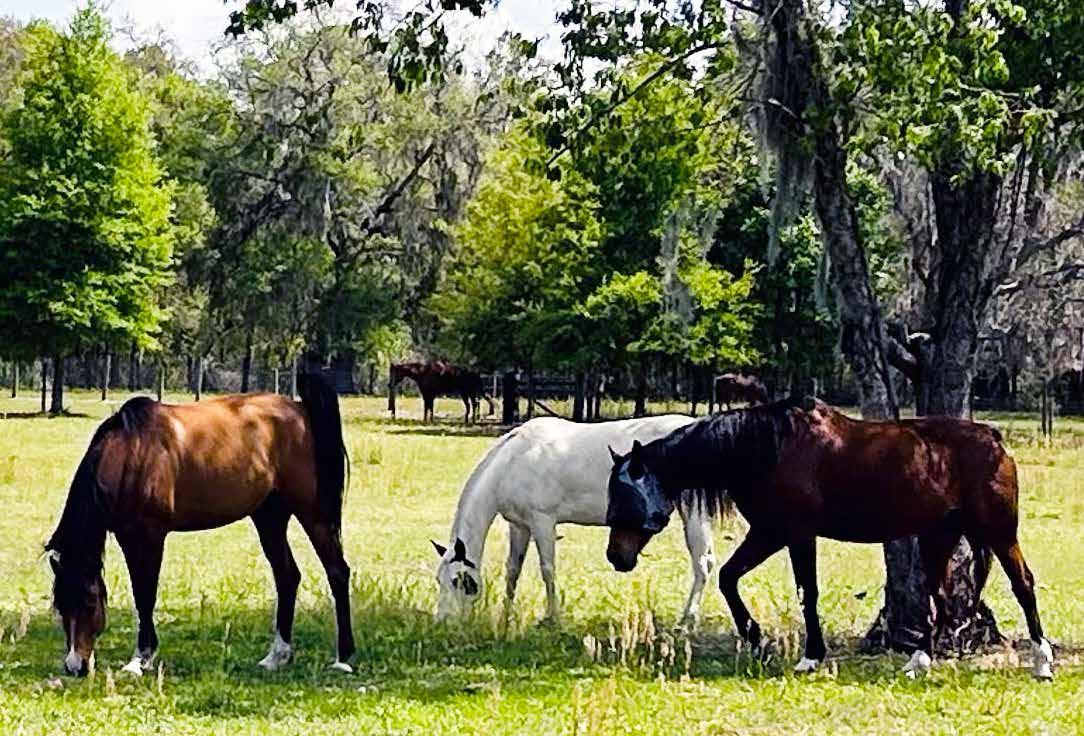

have risen to above 50 degrees and the grass is not so concerned about its survival. It is because of this phenomenon that summer pastures are relatively safe.
By July my pastures are totally shot, and the horses are eating almost as much hay as they do during the winter.
is surrounded by several misunderstood concepts.
All hay shares one common quality; the nutrient level is highly variable and determined by different factors. Maturity, drought, wet, temperature and time of day the stalks are cut will all contribute to the nutrient levels in hay.
Cool season grasses are found in the northern, cooler climates and are generally higher in nutrients than warm season grasses. Cool season grasses are softer, more palatable and more digestible than warm season grasses. Because of longer daylight hours in northern latitudes the growing season is longer, and yields are higher for cool season grasses.
Spring is so dangerous because the air temperatures are relatively cool at night, but the sun heats the grass which stimulates growth. Have you ever noticed that during the spring months you may mow your lawn twice a week? Well, there you go! During the spring the sun is helping to make huge amounts of sugar that is being sent to the roots for use as food when it gets cold.
When turning out on spring grass you should wait until the grass warms sufficiently to get the sugars going back into the roots. The rule of thumb around here is wait until the dew is off the grass plus thirty minutes and you should be safe. SHOULD be safe. If you are turning out on spring pastures, please watch each horse closely.
During the summer grass will slow its growth based on rainfall and temperature. Typically, by mid-July pasture grass will stabilize because the overnight temperatures will
The bottom line for me is that if you have horses at risk of metabolic disorders of any kind or carry too much extra weight when the pastures green up you should muzzle them, limit turn out or put them on dry lots. Grass will kill the wrong horse.
I am frequently asked about the best way to improve pastures, and my reply is generally “don’t.” Encourage the crabgrass to grow for erosion control and something to keep them busy. Now, I have three chunky quarter horses and one thoroughbred. If you have a farm full of lanky athletes, then it may be a different story.
Hay for Horses
Cutting, drying and baling quality horse hay is more art than science and is limited by many variables like weather, timing, maintenance and equipment failures to name but a few.
There are two types of hay we offer to horses; grass and legume. Grass is the most fed hay and comes in many different varieties. Alfalfa is the most common legume hay and
Grass Hay
Grass hay is made from different species of grass and is characterized by a long continuous leaf from root to seed head. There are numerous varieties of grass hay depending on the region of the country it’s grown.
Cool season grasses are typically higher in non-structural carbohydrates (NSCs) but keep in mind that the level of NSC is highly variable.
Some common examples of cool
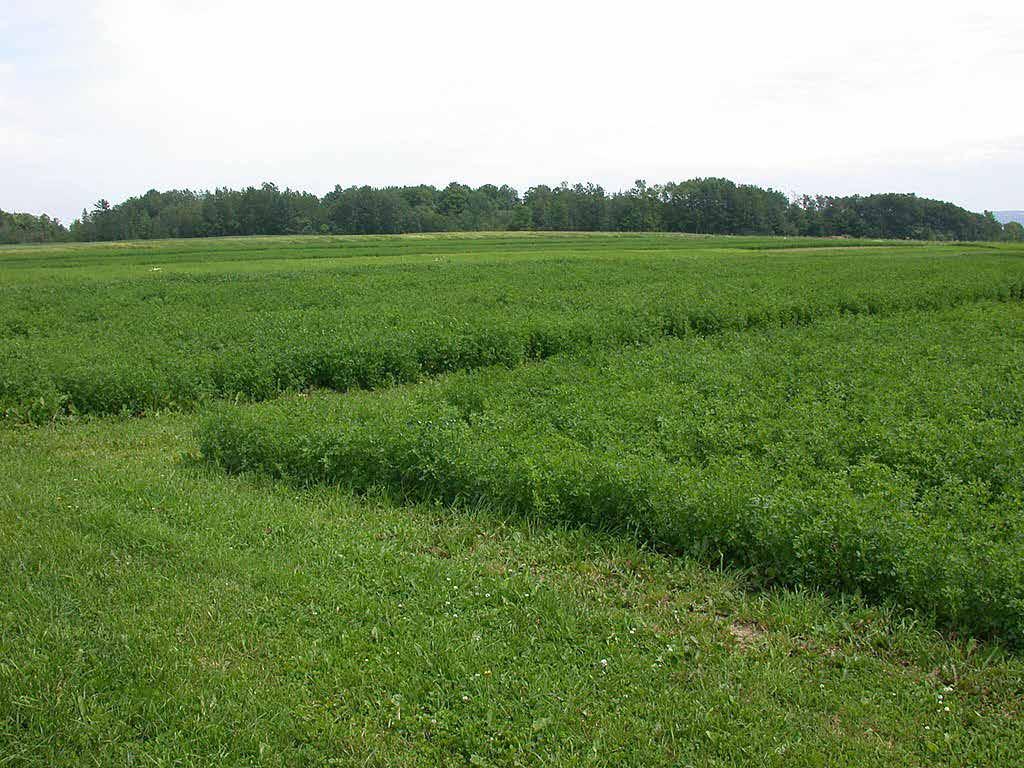
season grass hay are orchard, timothy and fescue.
Warm season grasses are usually found in the southern U.S. Warm season grasses are generally less palatable and digestible for horses. They are more fibrous and lower in sugar making them harder to chew and less tasty at the same time.
Some common examples of warm season grass hay are bermuda and St. Augustine.
Legume Hay
Legumes can be a good source of forage for some horses because they are generally highly nutritious while being low in NSC. However, because of the nutrient density in legume hay it can be a bit trickier to feed as a sole source of forage for some horses.
Protein is high and the calcium to phosphorus ratio is unbalanced. Legume hay is generally 30% to 50% higher in calories as well as much more palatable than most grass hay so while low NSC is great for you IR horses many of those horses are obese, so additional calories are not going to be helpful.
Legume hay is more difficult to make than grass hay. The moisture limitations are much narrower than grass hay. Legumes, unlike grass, have a central stalk with leaves, like miniature trees. If legume hay is too dry these leaves will not survive the baling, transportation and feeding
process. On the other hand, if the hay is made too wet then mold becomes a problem.
The most common legume hay is alfalfa. Clover and peanut hay are other examples.
Why Nutrients in Hay Vary
Hay is made from plant matter, and many variables affect the quality and quantity of all plants. Water, soil quality, fertilizer, weed control, temperature will all play a role in the nutrient levels of your hay.
Sugar and starch are one of the biggest variables in hay because in addition to all those other variables sugar and starch can vary greatly depending on what time of day the grass was mowed! The cycle of sugar production and storage was explained earlier, and this process is why sugar and starch in hay is so inconsistent.
If the hay is mowed after a chilly spring night at 8 a.m. the sugar and starch will be much higher than if the same field is mowed at 3 p.m. Of course, the hay farmer will prob ably not mow until the dew is off the field so the sugar and starch es might be lower unless it’s late spring in which case the sugars may be high due to a growth spurt.
I have tested hay from the same harvest but taken a week apart, and the NSC levels were completely dif ferent. Crazy, isn’t it?
In general, the more mature the hay the lower the nutrient and sugar levels. The reason behind this is that everything in nature that reproduces gives all its resources to its babies, and grass is no different.
When grass is young before the seed heads appear, the stalks are full of sugar and nutrients meant for creating healthy seeds—grass babies. Once the seeds are formed most of the nutrients have been used up. That’s why grass turns brown and icky in the fall.
A better example may be a fruit tree. Think of apples as grass seeds. Near the end of the apple’s growing season the apples are very sweet because all the sugars have been pushed into the fruit to sustain the
seeds to reproduce the tree. Shortly after the fruit is finished the tree goes dormant for the winter storing up nutrients for spring.
Look at your hay. If you are looking at soft, broad leaf stalks with no or very small seed heads the hay is young and full of nutrition. It’s also full of NSC so young, nutritious hay may not be the best suited for your metabolic horses.
If your hay is stemmy and has fiveinch-long seed heads it’s probably not very nutritious but will probably be lower in NSC.
Forage—Cornerstone of the Equine Diet

Taking the confusion out of feeding your horse

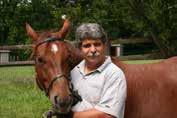
Space limits the amount of information I can offer here, but forage is the most critical component of the equine diet. In fact, the longest chapter in my book, Jim the Feed Guy’s Guide to Commercial Horse , is dedicated to a full understanding of forage and the role it plays in keeping our horses healthy.
Forage offers our horses fuel, mental stimulation, lower anxiety, gut buffering and hindgut efficiency among several other factors. It is essential that our horses have access to sufficient, quality forage.
Any feed program we choose for our horses must be built on a foundation of forage first. Once we have met the forage needs, we are then ready to determine what supplementation is required for our horses.
Murdoch Minute
No. 103: Press Back for Outside Leg
Do you have trouble getting your outside leg back? Does it drift forward instead? Does your leg feel “weak” or “ineffective”? In most cases the problem isn’t strength, but function. If you use your leg incorrectly it will feel weak no matter how much muscle strength you have. Aligning the thigh and opening the hip is the key to a strong outside leg.
Next time you ride notice what happens with your outside leg. Does it drift forward toward your horse’s shoulder? Is your heel turned inward? Is the stirrup pushed forward and heel braced down? Check a photo of your riding if you are not sure. Turning your heel toward the horse externally rotates your thigh and hip. Pushing against your stirrup will swing your leg forward. Combined external rotation and jamming your heel down will make it impossible for you to bring your leg back! Move from the hip
Your hip joint can move in many directions. Depending on the movement in the hip the leg will move in a specific direction. Externally rotating your thigh causes your lower leg to swing forward. Internally rotating the thigh too much will cause you to grip. Rid-
By Wendy Murdoch
ing with your thigh in a neutral position, between internal and external rotation will allow your lower leg to go back when you lengthen your leg back and down from the hip. To have your outside leg that goes back (as it should when riding) make sure not to turn your knee out!
Unmounted
Test this by on sitting on an office chair with a pedal base (so you have room to move your leg) and lift one foot off the ground. Turn your knee out and notice you could easily kick a soccer ball forward with your leg in this position. Extend your foot by pressing into your heel and your leg moves forward, in front and away from you. Now try to move your leg back from your hip. You won’t be able to go very far! You might get your thigh perpendicular to your body but not behind unless you turn your body to move your leg. Your thigh cannot go behind you in this position.
Turn your knee inward, as if to cross the thigh over the other leg, you have inwardly rotated the hip. Press your foot back while maintaining inward rotation. The foot will move behind and away from you. You can’t internally rotate this much on a horse because


Photo 1 (above left). The rider’s leg is externally rotated from her hip. She is flexible enough to bring her leg to the side but in the stirrup the foot will move forward instead of back.
Photo 2 (right). Out of the stirrup, knee bent to 90 degrees the rider is pressing the whole foot back while keeping her seat in the saddle.
Photo 3 (below left). Lengthening the heel back and down with the thigh in a neutral position and knee slightly bent.
he is between your legs!
Bring your thigh to neutral, between internal and external rotation. Your knee will point straight ahead. Bend the knee so your lower leg clears the floor and press your foot back. Your leg moves behind you as your hip opens. Your thigh will become more vertical depending on the height of the chair and your lower leg moves back. This thigh position is required for a strong outside leg position.
Mounted
On your horse drop one stirrup and let

your leg hang. Turn your heel in, thigh out observing that the back of your leg is on the saddle. If you press into your heel your leg moves forward. Rotate your hip until the flat of your thigh is on the saddle. Bend your knee to a right angle and press your foot back as if against a wall behind you. Feel how your hip opens, thigh lengthens toward the ground and leg moves back toward your horse’s tail. Straighten your knee a little and press back and down again. Return your foot to the stirrup. Repeat the exercise making sure your heel moves back and not forward. Press from your hip. Your leg should go back and down even when in the stirrup. If your foot moves forward you have either turned your heel in again or put too much pressure on the stirrup. Repeat on the other side.
Use this Murdoch Minute to open your hip for a correct outside leg position. When the thigh is in neutral your heel will go back and down toward your horse’s hind foot. And always remember to enjoy the ride!
Be Pro-active Rather than Reactive with Biosecurity
By Jackie Bellamy-Zions, Equine Guelph, Ontario, Canada
“In the equine industry, true biosecurity is hard to achieve because horses move around a lot, and many diseases are always present,” says Ontario Veterinary College infectious disease specialist Dr. Scott Weese. “However, it’s still important to try to prevent diseases from entering and to have plans in place to manage any outbreaks.” With frequent horse movements, endemic pathogens and emerging diseases, there is a need for improved understanding and motivation to adopt better infection control practices.
Infection control begins in the barn and works best when the focus is pro-active rather than reactive. This includes having an access management plan, proper quarantine protocols for new and returning horses, and training EVERYONE who comes on to the property or handles the horses.
Access Management
Controlling how horses, humans, equipment and vehicles can move into and around your farm are all aspects of access management aimed to reduce the transmission of pathogens.
Access management begins at the
entrance, where a training facility may use fencing and gated entries to restrict access to the stables and training areas, ensuring only authorized personnel can enter. Procedures at controlled access points such as hand sanitizing and boot cleaning help prevent the spread of infections. Both staff and service providers need to be made aware of any infection control measures in place. Clean outerwear that has not been worn to another barn are also recommended to prevent potential spread of disease.
A sign in procedure can be made mandatory for visitors. A log can be helpful to help trace the problem in the event of a disease outbreak. Providing guided tours can ensure they do not enter restricted areas. Additional signage can let visitors know where they can and cannot go.
Controlled access zones can designate specific areas for different activities, such as quarantine zones for new arrivals and separate zones for resident horses, with controlled access points to manage movement.
Isolation/Quarantine
When horses return home or new horses arrive, such as from a sale, it is a good idea to implement quarantine and/or isolation protocols.
Ideally this involves housing in a separate building away from your resident horses, but it may be the end of an aisle with several empty stalls in between.
New and returning horses are kept separate and monitored for at least 14 days. This involves twice daily temperature checks and health checks including watching water consumption, appetite, urination, manure and any signs of illness. Turn out paddocks should also be away from other resident equines, especially if that includes higher risk horses like broodmares and foals. Effective quarantine includes using separate equipment for isolated or quarantined horses to avoid cross-contamination. This includes water buckets, feed tubs, grooming equipment as well as wheelbarrows, brooms, pitchforks and other cleaning tools.
Ideally, new and returning horses are handled by separate staff. Otherwise, quarantined horses are worked with last & hands are washed before & after each interaction. Strategically placed alcohol-based sanitizers can also be used. If wash stations are limited, this makes it easier for staff and visitors to follow infection control protocols. Disposable gloves, disposable shoe covers & protective
clothing are also best practices. Barn cats and other pets should not be allowed to enter the quarantine area.
If you have a number new or returning horses in quarantine and one shows signs of illness, it should be further separated into isolation and seen by a veterinarian ASAP. Horses should remain in isolation until cleared by the vet, as the horse may have recovered from clinical signs but still be infectious. Signage once again should alert unauthorized persons at the entrance of any areas used for isolation or quarantine.
Not Sharing is Caring and Hygiene Practices
Of course, those new or returning horses should be housed in a stall that has been both cleaned and disinfected prior to their arrival. Cleaning involves removing all visible manure, bedding and soil before washing the area with soap and water and then allowing it to dry. Then apply a disinfectant such as Virkon or other disinfectant recommended by your veterinarian. All disinfectants have strengths and weaknesses and are best used for specific purposes. Bleach has drawbacks as hard water can affect its effectiveness, it can be inactivated by organic material, and it can be irritating
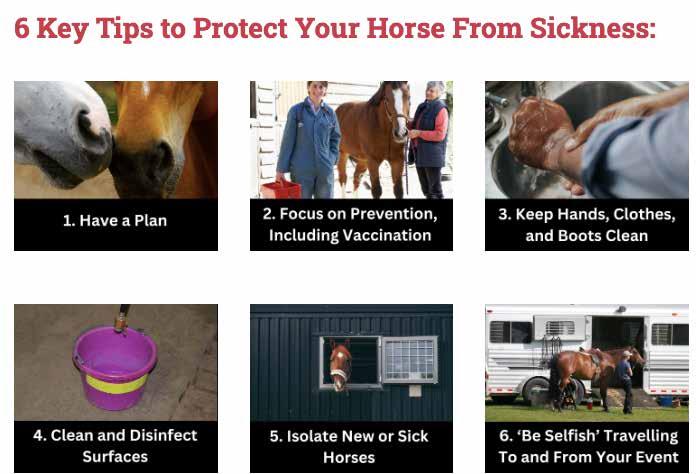
to the horse. Steer clear of pressure washers as they can aerosolize certain viruses.
An often-misused step, if you will pardon the pun, is the foot bath. One cannot just walk through without first going through the same routine as mentioned above, both cleaning and disinfecting. First remove debris from the footwear, including the soles using a brush or hose to get all the dirt out of the treads. Immerse the entire bottom of footwear in the disinfectant and scrub. Following the contact time on the product label is important and a dirty footbath does little in the way of boosting biosecurity. Then wash your hands. Other options include
dedicated footwear and disposable shoe covers.
Hand hygiene cannot be overstated as one of the most important infection control measures. Best practices on application time for the soap or alcohol-based sanitizer is 20 – 30 seconds.
Everyone knows not to share communal water, but it is also important not to become blasé about biosecurity when it comes to filling or refilling water buckets. Submersing a hose from one bucket to the next or letting it touch the buckets can be a free ride for a pathogen looking for its next host. So instead of multi-tasking while filling buckets,
one could be enjoying a beverage with their free hand.
Not sharing should extend beyond grooming equipment to tack, pads, blankets, and of course medical supplies like syringes, needles and dewormers.
More disease prevention measures include minimizing the presence of rodents and insects by keeping feed secure, eliminating standing water and regular removal of manure from stalls and paddocks and as well as management of manure storage areas.
Vaccination
Vaccination is a crucial aspect of equine healthcare, but vaccines do not provide immediate protection; it can take days or weeks for a horse to develop optimal immunity after vaccination, so timing is very important. Planning ahead will allow vaccines to be given well in advance of the next stressor such as travelling or competition.
While no vaccine boasts 100% immunity, horse owners can rest assured that they are taking proactive steps to maintain their horse’s health, minimizing the risk of unexpected veterinary expenses. Vaccines significantly reduce the risk of disease which means if a vaccinated horses does get sick, they will generally experience milder symptoms and recover more quickly.
Working closely with a veterinarian
to develop and maintain a vaccination program is an important step for optimal equine health. In addition to core vaccinations, your vet will know what diseases are endemic and emerging in your region or regions you will be travelling to. The frequency of your vaccinations or boosters will depend on a number of factors including special circumstances, such as an extended vector season or even a significant wound if it is incurred over 6 months after a Tetanus shot. The length of your competition season may also necessitate a booster of certain shots to maintain optimal immunity.
Emerging Diseases
Infection control specialist Dr. Weese says, “Understanding potential mechanisms of transmission is the basis of any infection control or biosecurity program.”
Most diseases in horses are caused by pathogens that mainly infect horses. They can spread continuously without needing long-term hosts (like the equine flu virus). They can remain in the horse without causing symptoms for a long time (like Strangles). Some cause infections that can come back at any time (like equine herpesvirus). Others may be part of the normal bacteria in horses but can cause disease if given the chance (like staphylococci and Enterobacteriaceae).
Horses can spread these germs even if they seem healthy, before showing symptoms, after recovering, or
as part of their normal bacteria. This makes it hard to identify which horses are infectious. Some symptoms, like fever and diarrhea, strongly suggest an infection, but any horse can potentially spread germs. Therefore, it’s important to have strong infection control practices to manage the risk.
In 2024, the Equine Disease Communication Center (EDCC) reported 577 Alerts for 813 confirmed cases of disease in North America. The most frequently reported disease was Strangles with 186 cases. Because Strangles is not reportable in all states or provinces the disease is likely much more prevalent than reported to the EDCC. Other frequently reported illnesses include: 153 West Nile Virus (WNV), 125 Eastern Equine Encephalitis (EEE), 109 Equine Infectious Anemia, 73 Equine Herpesvirus- Neurologic, 8 Equine Herpesvirus- Respiratory, 34 Equine Influenza.
• Strangles: A bacterial infection caused by Streptococcus equi, leading to swollen lymph nodes and respiratory issues. It is highly contagious and spread through contact. This could be nose-to-nose between horses or via contaminated surfaces or equipment such as: shared halters, lead shanks, cross ties, feed tubs, stall walls, fencing, clothing, hands, the hair coat from other barn pets, grooming tools, water buckets, communal troughs.
After an outbreak, cleaning should
involve removal of all organic material from surfaces and subsequent disinfection of water containers, feeders, fences, stalls, tack and trailers.
• West Nile Virus (WNV): a mosquito-borne virus leading to neurological issues such as inflammation of the brain and spinal cord. WNV can be fatal and survivors can have residual neurological deficits for a period of months to permanent disability.
• Eastern Equine Encephalitis (EEE): another virus transmitted by mosquitos Eighty to ninety percent of infected horses develop acute and fatal neurologic disease.
• Equine Infectious Anemia (EIA): is a blood-bourne virus which can be transmitted by insects, medical equipment or passed from mare to foal in utero. With no treatment or cure, horses confirmed positive by a Coggins test can be quarantined for the rest of their life but are usually euthanized.
• Equine Herpesvirus (EHV): This virus had multiple strains and can cause both abortion and neurologic symptoms. Spread via aerosol particles from nasal discharge or from contaminated surfaces. There are vaccines for respiratory and abortive strains but not the neurologic form of EHV-1 (EHM).
These diseases highlight the importance of biosecurity and vaccination
in managing equine health. Tetanus, rabies, West Nile virus and eastern equine encephalitis are core vaccinations veterinarians recommend.
In February 2025, Equine Guelph partnered with the Equine Disease Communication Center (EDCC), to help horse owners assess and manage infectious disease risks with the relaunch of Equine Guelph’s Biosecurity Risk Calculator (TheHorsePortal.com/BiosecurityTool). The interactive free tool is Equine Guelph’s tool of the month for May, and it is full of useful information from quarantine protocols, best practices for cleaning, and easy to understand practical access management tips. In just 10 minutes, you can assess and minimize biosecurity threats for your barn.
“Applying routine and basic biosecurity is the best way to prevent infectious diseases,” says Dr. Nathaniel White the Director of the EDCC.
“This includes isolation of new horses introduced to facilities, monitoring horses’ temperature and preventing horse to horse contact while
traveling and keeping vaccinations up to date. Being aware of disease prevalence using information from the EDCC and the updated “Biosecurity Risk Calculator” can help owners use management practices to decrease disease risk.”
Equine Infection Control Measures During Transport
Pre-transport preparations entail more than just having your paperwork in order.
Taking the time to clean and disinfect the trailer or make sure the trailer you have hired always cleans between loads is of paramount importance. If the trailer smells like horses, it was not adequately cleaned. Perform a horse health check before you leave the property. It is not worth the gamble to stress a horse with travel when it is ‘notquite right’.
Being particular about your horses traveling companions is just as
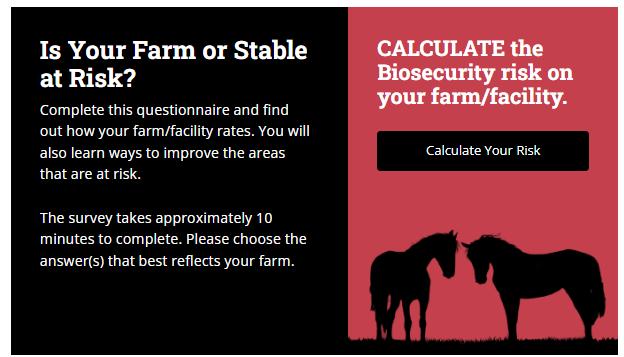
important as the cleanliness of the trailer. Avoid travelling with horses from other locations as being in close quarters increases the risk of picking up an infectious disease. Tie the horse loosely if possible. Horses tied short are less ability to lower their head to clear mucus. Allowing freedom of head movement can reduce stress and the bacterial load in the airways. Similarly, hay nets that are hung high, encouraging a high head position, and introducing dust and debris, can challenge mucous clearance.
Ventilation is another important consideration as improving air exchange can reduce the dust and mold spores hanging in the air. Drafts on the other hand can blow particles around in the trailer. Many prefer shipping in leather halters because they will break in an emergency but there is a biosecurity benefit too as they are easier to clean. Bacteria can linger in the webbing of polyester halters.
Biosecurity is just as important on
the road and when visiting other venues. Disease is easily spread through equipment sharing. While visiting venues off the farm be sure to bring your own broom and shovel for cleaning your trailer. Pack a thermometer along with your tack and other equipment. Clean & disinfect your equipment when you get ready to leave your off-site location.
Upon returning to the home farm, the cycle begins again, monitoring horses for possible delayed onset of symptoms.
To ensure effective infection control, it is crucial to maintain a proactive approach starting right in the barn with a plan. Implementing access management, enforcing proper quarantine protocols for new and returning horses, and thoroughly training everyone who enters the property or handles the horses are essential steps. By taking these practical steps, we can significantly reduce the risk of infections and promote a healthier environment for all.
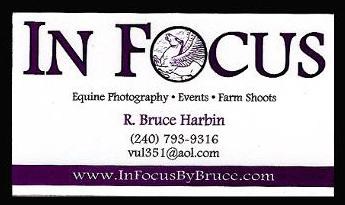
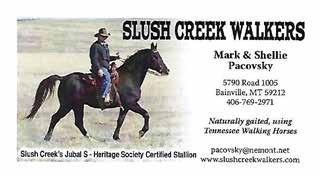
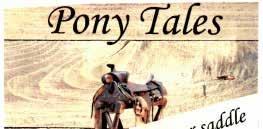


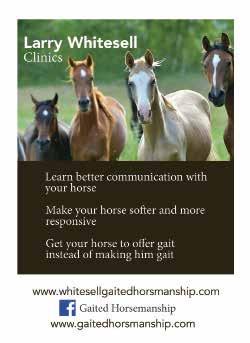
OUR FOREVER FRIENDS
FOSH Lifetime Members
Jo Anne Behling, Wauwatosa, WI
Esther L. Bell, TN
Pamela Brand, Carlisle, PA
Sarah Bushong-Weeks, Denver. CO
Julie Church, Pagosa Springs, CO
Mary & William Church, Pagosa Springs, CO
Luella DeBono, Eden Prairie, MN
Beverly Foster, St. Augustine, FL
Nancy Gillespie, Pullman, WA
Cristine Holt, Dubuque, IA
Jane Howlett, Pocatello, ID
Marjorie Lacy & Walking Horse News, Edson, Alberta
Sue De Laurentis, Dripping Springs, TX
Bobbie Jo Lieberman
Dianne Little, Calgary, Alberta
Debbie Locke, Mack, CO
Ann Loveless, Ashtabula, OH
Patricia Mayer, East Aurora, NY
Janelle T. McCoy, Prague, OK
Frank Neal, Nashville, TN
Lori Northrup, Ellicottville, NY
Anne Northrup, Ellicottville, NY
Shellie Pacovsky, Bainville, MT
Denise Parsons
Anita Rau, Catlett, VA
Debbie Rash, Chino, CA
Southern Comfort Gaited Horse Club, ID
Bucky & Nancy Sparks, Cortez, CO
Marcy Wadington, Canon City, CO
Leslie Weiler, Pagosa Springs, CO
Laura Wyant, Chesire, OR
An Anonymous Donor
Yankee Walkers of New England



“Without
Soring
Soring
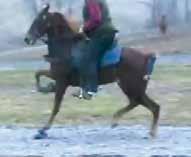
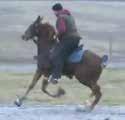
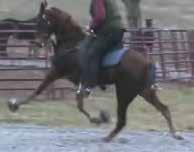
the chains, there would be no need
d a
“Without the chains, there would be no need for a scar rule.”
for a scar rule.”
– humane acTivisT, may, 2011.
– humane acTivisT, may 2011.
ho W t o d ete ct
ho W t o d ete ct
• Palpation
• Palpation
“That
Chemical Soring
Chemical Soring

W h at i s s oring ?
W h at i s s oring ?
Soring is deliberately inducing pain to exaggerate a gaited horse’s movement for the show ring. A variety of devious and cruel methods have been devised over the years. Soring violations also include many methods used to avoid detection. Soring is against Federal law and is subject to fines and penalties if detected at a public show or sale.
Soring is deliberately inducing pain to exaggerate a gaited horse’s movement for the show ring. A variety of devious and cruel methods have been devised over the years. Soring violations also include many methods used to avoid detection. Soring is against Federal law and is subject to fines and penalties if detected at a public show or sale.
Chemical soring is the application of painful, caustic liquids to tenderize the horse’s pastern area (ankle), so the repeated strike of a chain is painful and causes the horse to snatch his foot higher with each step. The chain, a crucial part of this show horse style, is termed an “action device,” and the exaggerated gaits cannot be created without this chain.
ho W i t ’ s d one
ho W i t ’ s d one
ho W t o d etect
ho W t o d etect
Observations:
Observations:
• Horse lies down in stall and groans in pain.
• Horse lies down in stall and groans in pain.
• Horse is crampy and unwilling to move.
• Horse is crampy and unwilling to move.
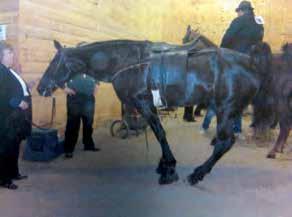
“That just looks wrong.”
Chemical soring is the application of painful, caustic liquids to tenderize the horse’s pastern area (ankle), so the repeated strike of a chain is painful and causes the horse to snatch his foot higher with each step. The chain, a crucial part of this show horse style, is termed an “action device,” and the exaggerated gaits cannot be created without this chain.
• Gas chromotography or “sniffer”
• Gas chromotography or “sniffer”
• Thermography
• Thermography
10-year-olD boy while waTching viDeo of a “big lick” horse shown in sTacks anD chains, June 10, 2011.
• Blood or saliva tests
just looks wrong.” 10-year-olD boy while waTching viDeo of a “big lick” horse shown in sTacks anD chains June 10, 2011.
• Blood or saliva tests
• Drug-detection trained dog
• Drug-detection trained dog
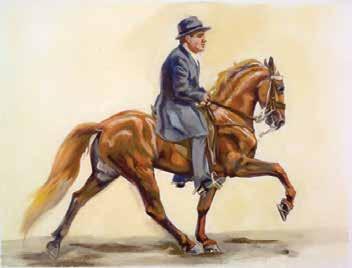
• Horse warms up into motion with a “praying mantis stance,” with abnormal weight thrown on his hind quarters to avoid front end pain.
• Horse warms up into motion with a “praying mantis stance,” with abnormal weight thrown on his hind quarters to avoid front end pain.
• Horse stands in classic “standing in a bucket” pose to alleviate pain in front legs (photo above).
• Horse stands in classic “standing in a bucket” pose to alleviate pain in front legs (photo above).
• kerosene
• kerosene
• diesel
• diesel
• croton oil
• croton oil
• GoJo hand cleaner
• GoJo hand cleaner
• WD40 oil
• WD40 oil
• mustard oil
• mustard oil
Soring includes the abuse of chains, foreign substances and chemicals, illegal shoeing to change the natural hoof angles, length of toe, weighted shoes, pressure shoeing, as well as the insertion of blocks and other devices between the hoof and the shoe stack to place pressure on the frog and sole of the foot to create pain in the front end of the horse. These methods all cause the horse to attempt to avoid the pain by picking up his front feet faster and higher, and shifting his weight back onto his hocks. Slang for an obviously sore-going horse is “going too deep.”
Soring includes the abuse of chains, foreign substances and chemicals, illegal shoeing to change the natural hoof angles, length of toe, weighted shoes, pressure shoeing, as well as the insertion of blocks and other devices between the hoof and the shoe stack to place pressure on the frog and sole of the foot to create pain in the front end of the horse. These methods all cause the horse to attempt to avoid the pain by picking up his front feet faster and higher, and shifting his weight back onto his hocks. Slang for an obviously sore-going horse is “going too deep.”
With the increased scrutiny of soring-related scars, another cruel practice is used to remove the telltale scarring. The horse’s legs are covered in a chemical stripping agent, which burns off old scar tissue through a very painful process.
Wh Y is t h is a b use d o ne?
• Visual inspections for:
• Visual inspections for:
Wh Y is t h is a b use d o ne?
Soring is practiced to get gaited horses to artificially enhance their step to win in shows. A winning image is rewarded with ribbons, cash, recognition, future breedings and training fees.
Soring is practiced to get gaited horses to artificially enhance their step to win in shows. A winning image is rewarded with ribbons, cash, recognition, future breedings and training fees.
en F o
– scarring and inflammation, signs of soring insults.
– scarring and inflammation, signs of soring insults.
– wavy, rippled, curly hair on the front legs, an indicator of repeated chemical soring with leg wraps.
– wavy, rippled, curly hair on the front legs, an indicator of repeated chemical soring with leg wraps.
rcement
en F o rcement
t o e nd s oring
t o e nd s oring
Chemicals are applied to the horse’s lower legs, then the leg is wrapped in plastic for days. This causes the chemicals to “cook” into the flesh. This creates highly sensitized front pasterns that are painful when the chain strikes with every step. Examples of soring chemicals used:
Chemicals are applied to the horse’s lower legs, then the leg is wrapped in plastic for days. This causes the chemicals to “cook” into the flesh. This creates highly sensitized front pasterns that are painful when the chain strikes with every step. Examples of soring chemicals used:
There is a federal law called the Horse Protection Act, which prohibits soring at shows and sales, enforced by the USDA. However, most inspections are selfregulated by HIOs (horse industry organizations licensed by the USDA.)
With the increased scrutiny of soring-related scars, another cruel practice is used to remove the telltale scarring. The horse’s legs are covered in a chemical stripping agent, which burns off old scar tissue through a very painful process.
There is a federal law called the Horse Protection Act, which prohibits soring at shows and sales, enforced by the USDA. However, most inspections are selfregulated by HIOs (horse industry organizations licensed by the USDA.) d a
“The
– cording, a type of scarring caused by the plastic wrap sliding down and tightly bunching around the pasterns.
– cording, a type of scarring caused by the plastic wrap sliding down and tightly bunching around the pasterns.
– checking for application of foreign substances, by walking the barns and trailers at a show.
– checking for application of foreign substances, by walking the barns and trailers at a show.
Pressure Soring
Pressure Soring
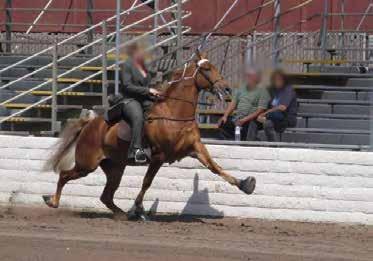
Pressure soring causes pain in a horse’s front feet, so when each front hoof hits the ground, the horse will “snatch” the foot off the ground, resulting in an unnatural, high, dramatic step.
Pressure soring causes pain in a horse’s front feet, so when each front hoof hits the ground, the horse will “snatch” the foot off the ground, resulting in an unnatural, high, dramatic step.
ho W i t ’ s d one
ho W i t ’ s d one
• Grinding the hoof sole down so thin “beads of blood show” and the sole gets spongy and super-sensitive.
• Grinding the hoof sole down so thin “beads of blood show” and the sole gets spongy and super-sensitive.
• Taking the hoof wall down slightly shorter than the sole, so it provides no supporting protection, called “rolling the sole.”
• Taking the hoof wall down slightly shorter than the sole, so it provides no supporting protection, called “rolling the sole.”
• Inser ting hard objects between the shoe or pad and the tender sole, such as bolts (removable for inspections), half a golf ball, hardened epoxy, or a dried piece of hoof.
• Inser ting hard objects between the shoe or pad and the tender sole, such as bolts (removable for inspections), half a golf ball, hardened epoxy, or a dried piece of hoof.
• Response to hoof testers (ideal if shoes are pulled first).
• Response to hoof testers (ideal if shoes are pulled first).
• Digital radiography (x-ray will show extreme thinness of sole, any foreign objects, or excessive coffin bone rotation).
• Digital radiography (x-ray will show extreme thinness of sole, any foreign objects, or excessive coffin bone rotation).
• Thermography to detect hot spots from pain.
• Thermography to detect hot spots from pain.
Methods Used to Avoid Detection at Inspection
Methods Used to Avoid Detection at Inspection
• numbing agents that wear off between inspection and show time (such as injected anesthetic, “the shot,” or surface application of Lidocaine).
• numbing agents that wear off between inspection and show time (such as injected anesthetic, “the shot,” or surface application of Lidocaine).
• “stewarding”: teaching the horse at practice inspections that flinching or reacting will cause worse pain, such as a beating or using a “hot stick” or electric prod.
• “stewarding”: teaching the horse at practice inspections that flinching or reacting will cause worse pain, such as a beating or using a “hot stick” or electric prod.
topical samples from Tennessee Walking Horses had the highest incidences of positives (of illegal substances from gas chromatography samplings)
“The topical samples from Tennessee Walking Horses had the highest incidences of positives (of illegal substances from gas chromatography samplings) that I’ve
ever seen in my life.”
that I’ve ever seen in my life.”
— Dr Tomas Tobin leaDing veTerinarian in Drug conTrol anD Toxicology in compeTiTion horses, november 5, 2010 www.thomastobin.com
— Dr. Tomas Tobin, leaDing veTerinarian in Drug conTrol anD Toxicology in compeTiTion horses november 5, 2010 www.thomastobin.com
Fixing … Touching … “putting them in a bucket” … Soap ‘em … Fly spray (a term owners use so they can avoid admitting knowing that an illegal substance has been used on their horse) … getting them right … brushing them … square ‘em up … head shake in a bottle … dropping them … Mojo (commonly used by people referring to GoJo hand cleaner) …
Fixing … Touching … “putting them in a bucket” … Soap ‘em … Fly spray (a term owners use so they can avoid admitting knowing that an illegal substance has been used on their horse) … getting them right … brushing them … square ‘em up … head shake in a bottle … dropping them … Mojo (commonly used by people referring to GoJo hand cleaner) …
• “Blocking,” which is standing the horse for hours on wedges duct-taped to the hoof.
• “Blocking,” which is standing the horse for hours on wedges duct-taped to the hoof.
• Purposely foundering a young horse (called “the natural fix” and “nature’s way of soring”).
• Purposely foundering a young horse (called “the natural fix” and “nature’s way of soring”).
• “Road foundering” the horse by riding fast on a hard surface such as a paved road.
• “Road foundering” the horse by riding fast on a hard surface such as a paved road.
• Extreme tightening of metal hoof bands to cause pain from excessive pressure on the hoof.
• Extreme tightening of metal hoof bands to cause pain from excessive pressure on the hoof.
• distraction devices: a nerve gum cord, bit burr under the saddle, hand twitch, alligator clips on sensitive genital tissue, or surgical staples under the mane, applied just before an inspection to cause distracting pain elsewhere during the inspection.
• distraction devices: a nerve gum cord, bit burr under the saddle, hand twitch, alligator clips on sensitive genital tissue, or surgical staples under the mane, applied just before an inspection to cause distracting pain elsewhere during the inspection.
• horse switching: providing a substitute horse for inspection under false paperwork, and then switching and putting the sored horse into the show ring.
• horse switching: providing a substitute horse for inspection under false paperwork, and then switching and putting the sored horse into the show ring.
fixing … pressure soring … “putting the fever in the foot” … pressure shoeing … “pinching the toes” … bolting … blocking … “under pressure” … “in a bind” … quicked … hot nailed … “tightened up” (for bands) … cranking …
“fixing below the pastern” … going too deep … concussion foundering … “peak point” describes the maximum pain point in the weekly soring process …
fixing … pressure soring … “putting the fever in the foot” … pressure shoeing … “pinching the toes” … bolting … blocking … “under pressure” … “in a bind” … quicked … hot nailed … “tightened up” (for bands) … cranking … “fixing below the pastern” … going too deep … concussion foundering … “peak point” describes the maximum pain point in the weekly soring process …
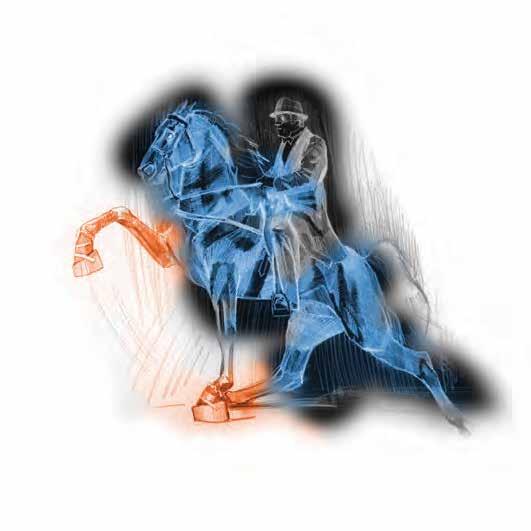
Chemical Soring
Chemical soring is the application of painful, caustic liquids to tenderize the horse’s pastern area (ankle), so the repeated strike of a chain is painful and causes the horse to snatch his foot higher with each step. The chain, a crucial part of this show horse style, is termed an “action device,” and the exaggerated gaits cannot be created without this chain.
ho W i t ’ s d one
Chemicals are applied to the horse’s lower legs, then the leg is wrapped in plastic for days. This causes the chemicals to “cook” into the flesh. This creates highly sensitized front pasterns that are painful when the chain strikes with every step. Examples of soring chemicals used:
• kerosene
• diesel
• croton oil
• GoJo hand cleaner
• WD40 oil
• mustard oil
With the increased scrutiny of soring-related scars, another cruel practice is used to remove the telltale scarring. The horse’s legs are covered in a chemical stripping agent, which burns off old scar tissue through a very painful process.
“Without the chains, there would be no need for a scar rule.”
– humane acTivisT, may 2011.
ho W t o d ete ct
• Palpation
• Gas chromotography or “sniffer”
• Thermography
• Blood or saliva tests
• Drug-detection trained dog
• Visual inspections for:
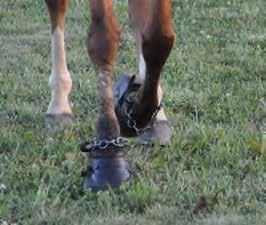
– scarring and inflammation, signs of soring insults.
– wavy, rippled, curly hair on the front legs, an indicator of repeated chemical soring with leg wraps.
– cording, a type of scarring caused by the plastic wrap sliding down and tightly bunching around the pasterns.
– checking for application of foreign substances, by walking the barns and trailers at a show.
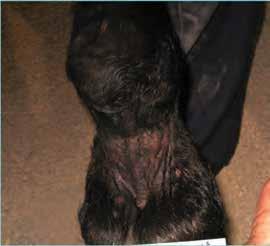


Fixing … Touching … “putting them in a bucket” … Soap ‘em … Fly spray (a term owners use so they can avoid admitting knowing that an illegal substance has been used on their horse) … getting them right … brushing them … square ‘em up … head shake in a bottle … dropping them … Mojo (commonly used by people referring to GoJo hand cleaner) …
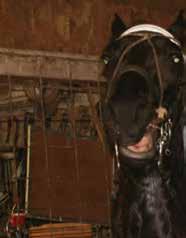

Observations:
etect

• Horse lies down in stall and groans in pain.
What Can Be Done to End Soring?
What Can Be Done to End Soring?
What W o uld have the biggest impact on eliminating soring?
What W o uld have the biggest impact on eliminating soring?
Pressure Soring
Pressure soring causes pain in a horse’s front feet, so when each front hoof hits the ground, the horse will “snatch” the foot off the ground, resulting in an unnatural, high, dramatic step.

positions who has had soring violations within recent years.
• Horse is crampy and unwilling to move.
• Join FOSH or the HSUS.
positions who has had soring violations within recent years.
• Horse warms up into motion with a “praying mantis stance,” with abnormal weight thrown on his hind quarters to avoid front end pain.
• Volunteer for FOSH projects to end soring.
• Join FOSH or the HSUS.
Voice Your Concerns
• Volunteer for FOSH projects to end soring.
Voice Your Concerns
• Horse stands in classic “standing in a bucket” pose to alleviate pain in front legs (photo above).
3q More money allocated to the USDA’s enforcement. At present, USDA’s inspectors attend only 7% of the shows, due to budget constraints. Relying on “self-policing” with industry inspectors has not been effective over the past decades.
3q More money allocated to the USDA’s enforcement. At present, USDA’s inspectors attend only 7% of the shows, due to budget constraints. Relying on “self-policing” with industry inspectors has not been effective over the past decades.
ho W i t ’ s d one
• Tell your Congressmen that you demand full enforcement of the law and adequate HPA funding.
• Tell your Congressmen that you demand full enforcement of the law and adequate HPA funding.
• Response to hoof testers (ideal if shoes are pulled first).
• Inform traditional show venues and their sponsors that you will not suppor t them because these shows encourage soring.
• Inform traditional show venues and their sponsors that you will not suppor t them because these shows encourage soring.
• Digital radiography (x-ray will show extreme thinness of sole, any foreign objects, or excessive coffin bone rotation).
3q Severe penalties for those guilty of soring. Substantial fines and mandatory, serious suspension periods for trainers and owners, including lifetime bans and prison time, would deter soring.
• Grinding the hoof sole down so thin “beads of blood show” and the sole gets spongy and super-sensitive.
3q Severe penalties for those guilty of soring. Substantial fines and mandatory, serious suspension periods for trainers and owners, including lifetime bans and prison time, would deter soring.
• Demand t hat the USDA and the industry inspectors enforce the law effectively.
• Demand t hat the USDA and the industry inspectors enforce the law effectively.
• Thermography to detect hot spots from pain.
Report Soring to the USDA, HSUS, and FOSH:
• Document soring incidences observed at barns or shows with photos or video and submit personally or anonymously.
Report Soring to the USDA, HSUS, and FOSH:
Methods Used to Avoid Detection at Inspection
3q Federal ban on “pads and action devices,” commonly termed “stacks and chains.”
3q Federal ban on “pads and action devices,” commonly termed “stacks and chains.”
W h at c an Y o u d o t o h elp e nd s oring ?
• Document soring incidences observed at barns or shows with photos or video and submit personally or anonymously.
• Report barns and trainers engaging in soring practices.
• Report scheduled “outlaw shows” organized without licensed HIO inspections.
• Report barns and trainers engaging in soring practices.
W h at c an Y o u d o
Learn More
• Taking the hoof wall down slightly shorter than the sole, so it provides no supporting protection, called “rolling the sole.”
t o h elp e nd s oring ?
Learn More
• Inser ting hard objects between the shoe or pad and the tender sole, such as bolts (removable for inspections), half a golf ball, hardened epoxy, or a dried piece of hoof.
• numbing agents that wear off between inspection and show time (such as injected anesthetic, “the shot,” or surface application of Lidocaine).
• www.StopSoring.com for latest news and facts on soring
• www.SoundHorseConference.com for presentation lectures on soring
• www.StopSoring.com for latest news and facts on soring
• www.SoundHorseConference.com for presentation lectures on soring
• United States Department of Agriculture (USDA) on Horse Protection www.aphis.usda.gov/animal_welfare/hp
• “Blocking,” which is standing the horse for hours on wedges duct-taped to the hoof.
Friends of Sound Horses, Inc. (FOSH)
• Report scheduled “outlaw shows” organized without licensed HIO inspections.
Lori Northrup, President 6614 Clayton Road #105, St. Louis, MO 63117 716-474-7580 • Lori@Northrup.com
Friends of Sound Horses, Inc. (FOSH)
• “stewarding”: teaching the horse at practice inspections that flinching or reacting will cause worse pain, such as a beating or using a “hot stick” or electric prod.
The Humane Society of the United States (HSUS)
Lori Northrup, President 6614 Clayton Road #105, St. Louis, MO 63117 716-474-7580 • Lori@Northrup.com
The Humane Society of the United States (HSUS)
• United States Department of Agriculture (USDA) on Horse Protection www.aphis.usda.gov/animal_welfare/hp
• Purposely foundering a young horse (called “the natural fix” and “nature’s way of soring”).
• Humane Society of the United States (HSUS) http://www.humanesociety.org/issues/tenn_ walking_horses
Get
• Humane Society of the United States (HSUS) http://www.humanesociety.org/issues/tenn_ walking_horses
Involved
• “Road foundering” the horse by riding fast on a hard surface such as a paved road.
Get Involved
• Extreme tightening of metal hoof bands to cause pain from excessive pressure on the hoof.
• distraction devices: a nerve gum cord, bit burr under the saddle, hand twitch, alligator clips on sensitive genital tissue, or surgical staples under the mane, applied just before an inspection to cause distracting pain elsewhere during the inspection.
• Run for a Board of Directors’ position with the Tennessee Walking Horse Breeders & Exhibitors Association (TWHBEA) and effect change from within.
• Run for a Board of Directors’ position with the Tennessee Walking Horse Breeders & Exhibitors Association (TWHBEA) and effect change from within.
Keith Dane, Director of Equine Protection 700 Professional Drive, Gaithersburg, MD 20879 301-258-3076 • kdane@hsus.org
Keith Dane, Director of Equine Protection 700 Professional Drive, Gaithersburg, MD 20879 301-258-3076 • kdane@hsus.org
United States Department of Agriculture, APHIS (USDA)
Dr. Rachel Cezar, Horse Protection Coordinator Dr. Chester Gipson, Deputy Administrator 4700 River Road, Suite 6D03, Riverdale, MD 20737 301-734-5784 • Rachel.Cezar@aphis.usda.gov
United States Department of Agriculture, APHIS (USDA)
• horse switching: providing a substitute horse for inspection under false paperwork, and then switching and putting the sored horse into the show ring.
• Propose changes to the TWHBEA bylaws that preclude anyone from holding leadership
• Propose changes to the TWHBEA bylaws that preclude anyone from holding leadership
Dr. Rachel Cezar, Horse Protection Coordinator Dr. Chester Gipson, Deputy Administrator 4700 River Road, Suite 6D03, Riverdale, MD 20737 301-734-5784 • Rachel.Cezar@aphis.usda.gov
“Call it what it is. This is torture.” — inTernaTionally-renown clinician february 2011
fixing … pressure soring … “putting the fever in the foot” … pressure shoeing … “pinching the toes” … bolting … blocking … “under pressure” … “in a bind” … quicked … hot nailed … “tightened up” (for bands) … cranking …
“fixing below the pastern” … going too deep … concussion foundering … “peak point” describes the maximum pain point in the weekly soring process …
FOSH Sound Principles

Principle #1
All FOSH events adhere to the requirements of the Horse Protection Act.
Principle #2
Horses are to be treated with dignity, respect, and compassion.
Principle #3
Horses must be presented as sound in both body and mind.
Principle #4
The preferred way of going is natural, correct, and without exaggeration.
Principle #5
Shoeing is intended only for the protection of the foot and its structure. Where practical, barefoot horses are both welcomed and encouraged.
Principle #6
Handlers and riders are expected to use training techniques and equipment that conform to the highest humane standards as recognized by the general equestrian community.
Principle #7
Exhibitors have a duty to conduct themselves in an orderly, responsible, and sportsmanlike manner.
FOSH is a national leader in the promotion of natural, sound gaited horses and in the fight against abuse and soring of Tennessee Walking Horses. For more information about FOSH or to become a member, please visit www. fosh.info.
Gaited Clubs
FOSH Directory
Southern Comfort Gaited Horse Club
Southern Comfort promotes activities highlighting the smooth ride and versatility of all gaited breeds. Pursuits include trail riding, competitions, shows, exhibitions, clinics and many other equine activities. The club promotes horse safety and friendship for all that are interested in horses. Owning a horse is not a requirement. SCGHC is based in southwestern Idaho and is a flat shod exclusive club with members contributing and supporting various interests using sound, natural horses. www.gaitedhorseclub.com
Chesapeake Plantation Walking Horse Club
The Chesapeake Club is celebrating over 25 years of promoting the versatile, naturally gaited, horse. As a member of the Maryland Horse Council, we have been the voice of the gaited community and through demonstrations, clinics and guest speakers, a resource for other disciplines to learn about the gaited breeds in our region. Members enjoy monthly trail rides, newsletters, parades, clinics, social gatherings, and friendly help. We welcome all breeds, riding styles, and experience levels from beginners to professionals. Cpwhclub. wordpress.com or jacquiecowan@comcast.net
Breeders
Summerwind Marchadors and Future Foal Breeders
Plan for your next lifetime partner! Come breed with us! Offering frozen semen (12 stallions in 2020) or reservations for Future Foals “do Summerwind” The Marchador is Brazil’s national horse, harking from Iberia, but bred there for 200 years. Expect to be impressed! http:// futurefoal.net or call Lynn @ 602-999-3915
Missouri Morgans
Easy gaited in color. Rare gaited Morgans located in the Heart of America near beautiful Lake of the Ozarks; for photos, videos and available horses. Talk to Jim or Vali Suddarth at 417-286-4720 or gaitedmorgans@missourimorgans.com

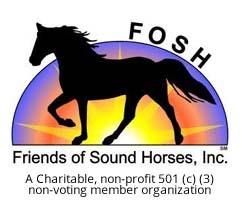
Friends of Sound Horses, Inc. Sound Show / Event Support Form
Please print or type information below
Name of Event:
Event Description: ______________ ____________ (show, clinic, expo, etc.)
Breeds Included: ____________________________________________________
Date(s) of Event:
Location of Event: ____________________________________________ (street)
__________________ (city) __________ (postal code) _____(state or province)
___________ (country)
Principal Contact Person: ______________________________(name)
Principal Contact Person Email: __________________________________
Principal Contact Person Phone: ______________________________
Name of Organization to RECEIVE Support Check: (check will be made out to…)
ADDRESS to where support check should be sent: ___ (street)
__________________ (city) ____________ (postal code) (state or province)
___________ (country)
If your event is approved, you should receive your support check within 30 days.
Please EMAIL this completed form to: president@fosh.info (faster) or mail to:
FOSH 6614 Clayton Rd., #105 St. Louis, MO 63117
For FOSH use only… Amount provided: _______________

Friends of Sound Horses, Inc. Scholarship Request Form
Please print or type information below
Student Applying: _________________________________(name) Age: ____ (yrs)
Student Email:
Student Phone: _____________________________________________________
Student Address: ______________________________________________ (street)
____________________ (city) __________ (postal code) _____(state or province)
___________ (country)
School Name:
Major: _ ____________
Date of Last FOSH show participation *:
Attach copy of acceptance letter and note date on letter here:
School Address: ____________________________________ (street) _____ (city) __________ (postal code) _____(state or province)
___________ (country)
Note: Checks will be made out to [Institution Name] for the benefit of [Student Name] and will be sent to the attention of the Financial Aid department. If you are chosen to receive a scholarship, you will be notified within 90 days of applying
Please EMAIL this completed form to: president@fosh.info (faster) or mail to: FOSH 6614 Clayton Rd., #105 St. Louis, MO 63117
For FOSH use only… Amount provided: _____________ Date sent: ____________
Scholarship Guidelines are on the following page (and do not need to be submitted with this form).
Please consider adding FOSH to your list of worthy causes in making a taxfree charitable deduction or help us to promote legislation, education, and training that protects and helps gaited horses, simply by renewing your own membership or giving a gift membership to a kindred spirit.
We know you have many choices when it comes to giving. Thank you for considering FOSH.

FOSH Membership Application and Order Form
All annual memberships include a digital, bi-monthly issue of the Sound Advocate & educational packets. Mail to: FOSH 6614 Clayton Rd. #105, St. Louis, MO 63117
Type of Membership (check one)
Annual: Single ___$30 Annual Family ___$50 Annual Youth <18 ___$20 Lifetime__$600 Organization Membership (for your gaited horse club or association) ___ $50
Please print neatly.
Name: _______________________________________________________________________
Enclosed: $____________________
How did you hear about FOSH?
